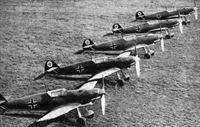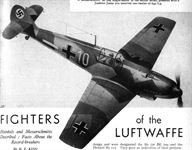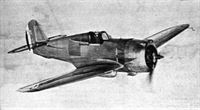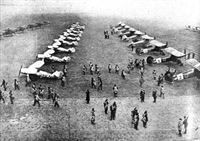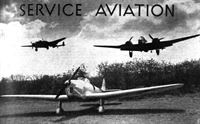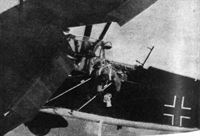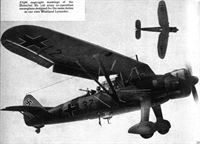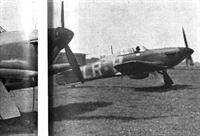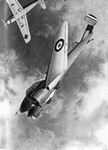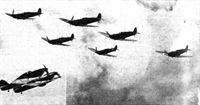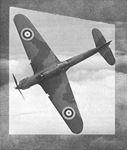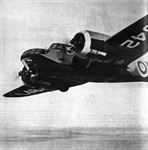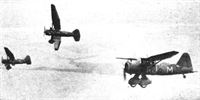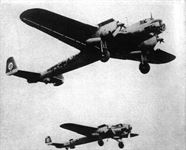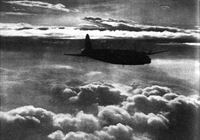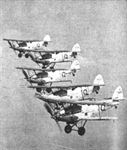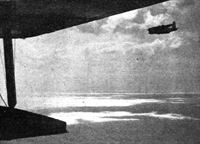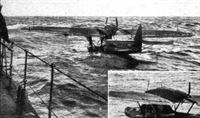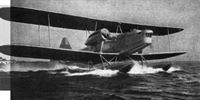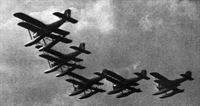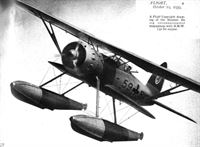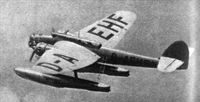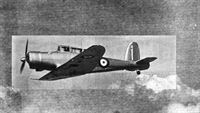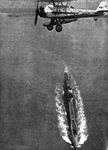Фотографии
-
Germany has developed a variety of types for naval catapult work. The machine is a twin-float Arado as carried on the "pocket battleship" Admiral Graf Spee
Самолёты на фотографии: Arado Ar.196 - Германия - 1937
-
A post-delivery line-up ol some of the lower-powered Me 109s. It will be seen that some have wooden airscrews and others metal.
Самолёты на фотографии: Messerschmitt Bf.109 / Bf.109B / Bf.109C / Bf.109D - Германия - 1935
-
A Bt 109 zooms dramatically. Exceptional powers of manoeuvre are claimed for this machine.
Самолёты на фотографии: Messerschmitt Bf.109 / Bf.109B / Bf.109C / Bf.109D - Германия - 1935
-
A GOOD SHOT: A Messerschmitt fighter brought down by French A. A. guns when about to attack an R.A.F. reconnaissance formation over Germany. The figure in the triangle on the side means that fuel of 87 octane was used in the engine.
Самолёты на фотографии: Messerschmitt Bf.109 / Bf.109B / Bf.109C / Bf.109D - Германия - 1935
-
A Messerschmitt Bf 109 single-seater ot the earlier series, powered with a Junkers Jumo 210 inverted vee-twelve of 640 h.p.
Самолёты на фотографии: Messerschmitt Bf.109 / Bf.109B / Bf.109C / Bf.109D - Германия - 1935
-
The Messerschmitt Bf 109 as fitted with a Daimler-Benz DB 600 engine (950 h.p.) and a three-bladed variable-pitch V.D.M. airscrew.
Самолёты на фотографии: Messerschmitt Bf.109 / Bf.109B / Bf.109C / Bf.109D - Германия - 1935
-
One of France’s American-built Curtiss Hawk 75As with Pratt and Whitney Twin Wasp engine. This machine is extremely popular and is armed with six machine guns.
Самолёты на фотографии: Curtiss Hawk 75 / P-36 / Mohawk - США - 1935
-
At a flying school in pre-war Germany. The monoplanes on the left are Focke-Wulf Stoesser, those on the right Heinkel H.E.51s. In the distance may be seen some Arados.
Самолёты на фотографии: Arado Ar.65 - Германия - 1931Focke-Wulf FW.56 Stosser - Германия - 1933Heinkel He-51 - Германия - 1933
-
The He 112U record-breaker. Showing the lines of the special He 112U, which attained a speed of nearly 464 m.p.h. The characteristics of the machine are shown here, though information on cooling is still lacking.
Самолёты на фотографии: Heinkel He-100 - Германия - 1938
-
A pastoral scene with a background of Heinkel He 112 fighters.
Самолёты на фотографии: Heinkel He-112 - Германия - 1935
-
The latest version of the He 112U which, although claimed to be in production for squadrons of the Luftwaffe, is very similar to the He 112U record-breaker.
Самолёты на фотографии: Heinkel He-112 - Германия - 1935
-
This Flight copyright drawing shows details of the Heinkel He 112 single-seater fighter with Junkers Jumo 210 engine. The armament depicted is two 20 mm. shell-guns mounted in the wings and a pair of synchronised machine guns. Several versions of the He 112 have appeared, but that shown is believed to be fairly typical.
Самолёты на фотографии: Heinkel He-112 - Германия - 1935
-
LOW APPROACH: Thanks to its slots and flaps the Handley Page Hampden can be operated from small aerodromes. A pair of Hampdens are seen approaching low with a Miles Magister in the foreground.
Самолёты на фотографии: Handley Page Hampden / H.P.52 - Великобритания - 1936Miles Magister / M.14 - Великобритания - 1937
-
Using a hand camera from the rear cockpit of a Henschel Hs 126.
Самолёты на фотографии: Henschel Hs 126 - Германия - 1936
-
A formation of Henschel Hs 126s. This machine is probably the most easily recognised of all the German service types.
Самолёты на фотографии: Henschel Hs 126 - Германия - 1936
-
Flight copyright drawings of the Henschel Hs 126 army co-operation monoplane designed for the same duties as our own Westland Lysander.
Самолёты на фотографии: Henschel Hs 126 - Германия - 1936
-
"The plain fact seems to be that our latest fighters are definitely better than their German counterparts." Hawker Hurricane formation.
Самолёты на фотографии: Hawker Hurricane - Великобритания - 1935
-
French and British single-seater fighters. The photograph shows two Hawker Hurricanes, one of which is just taking off.
Самолёты на фотографии: Hawker Hurricane - Великобритания - 1935
-
The Martin type 167 was ordered in considerable numbers by France before the outbreak of war. The type is a mid-wing monoplane.
One of the very latest attack-bombers which can be used either for normal bombing or for "strafing" ground targets: the Martin 167.Самолёты на фотографии: Martin Maryland / Type 167 - США - 1939
-
THE MODERN MORANES: During the war 1914-18 the name Morane was something to conjure with. Now the French Air Force is using large numbers of Morane 406 single-seaters with Hispano-Suiza 12Y moteur canon. Three of these machines are shown
Самолёты на фотографии: Morane-Saulnier MS.405/406/410C1 - Франция - 1935
-
Agile and versatile, the French Potez 63 multi-purpose monoplane, with two 700 h.p. small-diameter Gnome Rhone 14M engines, is a formidable adversary for the single-seater Messerschmitt Me 109. The Potez 63 is in service in considerable numbers and can be used for fighting, light bombing, ground attack, and reconnaissance. As a fighter it carries two 20 mm. Hispano shell-guns under the nose and one or more machine guns.
Самолёты на фотографии: Potez Potez 63 - Франция - 1936
-
"The plain fact seems to be that our latest fighters are definitely better than their German counterparts." Supermarine Spitfire formation.
Самолёты на фотографии: Supermarine Spitfire - Великобритания - 1936
-
A GOOD PLAN: The plan view of a draughtsman's general arrangement drawing could be little more accurate than this Flight photograph of a Fairey Battle single-engined bomber (Rolls-Royce Merlin engine). The Battle was the subject of one of the first “Expansion” orders and is doing excellent service. It is extensively used as a dive-bomber.
Самолёты на фотографии: Fairey Battle - Великобритания - 1936
-
BLIND-LANDING EXPERIMENTS: The Lockheed C40-B which will be used by the U.S. Army Air Corps for instrument-landing experiments. The machine weighs 9,200 lb. and carries a pilot and four test observers. It appears that the undercarriage is fixed; certainly this is true of the nose wheel, which is carefully faired. It will be noted that a conventional tail wheel is also fitted as a precautionary measure.
Самолёты на фотографии: Lockheed Electra Junior 12 - США - 1936
-
Регистрационный номер: L4842 BRISTOL BRILLIANCE: In its time the old Bristol Fighter was outstanding among military aircraft. Today the Blenheim carries on the tradition of the “Brisfit.” Fast, formidable, a revelation to fly, it has already achieved distinction on active service
Самолёты на фотографии: Bristol Blenheim IV/Bolingbroke - Великобритания - 1937
-
MULTI-PURPOSE: The Bristol Blenheim, although chiefly famed as a bomber, is adaptable, as a strategical reconnaissance machine or fighter. Vast quantities have been delivered to the Royal Air Force. The machines seen are of the Mark IV, or "long-nosed" variety. They have Bristol Mercury VIII engines.
Самолёты на фотографии: Bristol Blenheim IV/Bolingbroke - Великобритания - 1937
-
"Vital military information has been gained and recorded, and units have familiarised themselves with the country over which they will be called upon to operate." Westland Lysander army co-operation monoplanes may be assumed to be doing their share of the work on the Western Front.
Самолёты на фотографии: Westland Lysander - Великобритания - 1936
-
Регистрационный номер: G-AJMC This near-scale model of a Miles Magister won for Mr. J. Coxall the Bowden International Trophy for 1939.
Самолёты на фотографии: Miles Magister / M.14 - Великобритания - 1937
-
FOR GENERAL PURPOSES: The Arado Ar 95 is a sturdy, versatile biplane with B.M.W. 132 Dc engine. The large drawing shows it as a seaplane carrying a torpedo and bombs, though these are alternative loads. The smaller sketches show the landplane version the method of wing folding and the attachment of the torpedo.
Самолёты на фотографии: Arado Ar.95 - Германия - 1936
-
Typical of the larger twin-engined aircraft used in the Luftwaffe for strategical reconnaissance are these Dornier Do 17s. The machines shown are fitted with B.M.W. VI engines; later types have Daimler-Benz inverted Vs, B.M.W. 132s or Bramo Fafnirs
Самолёты на фотографии: Dornier Do.17 - Германия - 1934
-
Регистрационный номер: L4369 [2] A DANGEROUS VIEW for the pilot of an “E.A.” to have of the Vickers Wellington bomber is that shown here. The tail gunner can easily bring the stern armament to bear.
Самолёты на фотографии: Vickers Wellington / Type 271 - Великобритания - 1936
-
HOMING: After a long night’s flying a Vickers Wellington bomber approaches its aerodrome as the early sun tinges the clouds below. Soon the pilot will switch the blowers of his two Pegasus engines into low gear and descend.
Самолёты на фотографии: Vickers Wellington / Type 271 - Великобритания - 1936
-
Регистрационный номер: L4369 [2] "Some of the longer reconnaissance flights - of 1,000 miles or so - have been carried out at night under weather conditions of great difficulty." A Vickers Wellington above the clouds.
Самолёты на фотографии: Vickers Wellington / Type 271 - Великобритания - 1936
-
GROUND ATTACK: One of the most successful of the new types being introduced to the French Air Force is the Breguet 69 multi-purpose monoplane with two Gnome-Rhone 14M engines. Three of these attractive machines are shown performing the International Meeting at Brussels this summer.
Самолёты на фотографии: Breguet Br.690 - Франция - 1938
-
"Formidable-looking British fighter ’planes flying in perfect formation on patrol. These speedy machines are the equal of the vessels of their type in any country." Believe it or not, that was the caption supplied with this photograph, an it had been passed by Censor. Apart from tending to make the good old Hind look ridiculous, it is scarcely good propaganda for neutral countries, which are now being flooded with pictures of modern German military aircraft types.
Самолёты на фотографии: Hawker Hind - Великобритания - 1934
-
A Fieseler Storch, of the type which is used for certain army co-operation duties, showing its liberal supply of slots and flaps and the specially designed undercarriage.
Самолёты на фотографии: Fieseler Fi.156 Storch - Германия - 1936
-
“The activities of the Coastal Command, too have been unremitting and strenuous in the extreme from the first day of war.” Short Sunderlands on patrol.
Самолёты на фотографии: Short Sunderland / S.25 - Великобритания - 1937
-
A Dornier Do18K flying boat brought down during an attack on our Fleet.
Самолёты на фотографии: Dornier Do.18 - Германия - 1935
-
The crew of the Do18K preparing to launch their rubber dinghy. It was a flying boat of this type which, in 1938 made a catapult-launched non-stop flight from Start Bay, Devon, to Caravellas on the coast of Brazil, a distance oi 5,220 miles. The type is fitted with two Junkers diesel engines
Самолёты на фотографии: Dornier Do.18 - Германия - 1935
-
The He 59 (two B.M.W. VIs) now being relegated to training duties. It was used quite extensively during the war in Spain
Самолёты на фотографии: Heinkel He-59 - Германия - 1931
-
Obsolete as a first-line type, the Heinkel He 60 is used extensively for seaplane training. It a liquid-cooled B.M.W. VI engine.
Самолёты на фотографии: Heinkel He-60 - Германия - 1931
-
A Flight Copyright drawing of the Heinkel He 114 reconnaissance sesquiplane with B.M.W. 132 Dc engine.
Самолёты на фотографии: Heinkel He-114 - Германия - 1936
-
Регистрационный номер: D-AEHF An earlier type of He 115 with a shorter nose. The inspection ladders from the floats to the fuselage are interesting.
Самолёты на фотографии: Heinkel He-115 - Германия - 1937
-
A twin-engined general-purpose floatplane of the Luftwaffe is the Heinkel He 115 shown discharging its “tin fish” which is stowed internally.
Самолёты на фотографии: Heinkel He-115 - Германия - 1937
-
Регистрационный номер: L2951 Blackburn Skua of the Fleet Air Arm
Самолёты на фотографии: Blackburn Skua / B-24 - Великобритания - 1937
-
ATTEMPTED RETRIBUTION: The Fairey Swordfish which attacked the U-boat that had sunk the freighter Kafiristan. Bombs can be seen under the wings. This photograph was taken from the Atlantic Farmer which rescued the crew.
Самолёты на фотографии: Fairey Swordfish - Великобритания - 1934
-
Fairey Swordfish of the Fleet Air Arm
Самолёты на фотографии: Fairey Swordfish - Великобритания - 1934
-
SAME WEAPON, DIFFERENT ELEMENTS: A Vickers Vildebeest used for training pilots in the art of torpedo-dropping seen over a British submarine which also specialises in attacks with torpedoes. These are of heavier patterns.
Самолёты на фотографии: Vickers Vildebeest / Type 132 - Великобритания - 1928
-
The Messerschmitt Me 109 R, present holder of the world's speed record.
The most detailed view ever published of the Messerschmitt Bf 109R which, flown by Fritz Wendel, attained a speed of 755.138 km/hr. (460.225 m.p.h.). A special DB 601A engine giving something like 1,800 h.p. was installed. The cruciform tail is notable.Самолёты на фотографии: Messerschmitt Me.209 - Германия - 1938
-
HERCULES-POWERED: The prototype Fokker T.9 twin-engined bomber which has been adopted by the Dutch East Indian Air Force. Unlike the majority of its predecessors the T.9 is of all-metal construction. It is fitted with two Bristol Hercules fourteen-cylinder sleeve-valve radial engines giving a maximum output of at least 1,375 apiece. No figures have been issued but the top speed should be well in excess of 260 m.p.h.
Самолёты на фотографии: Fokker T.IX - Нидерланды - 1939
Статьи
- Flight
- Flight Advertisements

